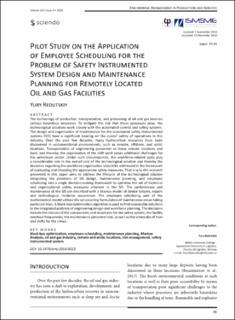| dc.contributor.author | Redutskiy, Yury | |
| dc.date.accessioned | 2023-09-28T11:28:00Z | |
| dc.date.available | 2023-09-28T11:28:00Z | |
| dc.date.created | 2019-01-02T10:20:29Z | |
| dc.date.issued | 2018 | |
| dc.identifier.citation | Engineering Management in Production and Services. 2018, 10 (4), 55-64. | en_US |
| dc.identifier.issn | 2543-6597 | |
| dc.identifier.uri | https://hdl.handle.net/11250/3092697 | |
| dc.description.abstract | The technology of production, transportation, and processing of oil and gas involves various hazardous processes. To mitigate the risk that these processes pose, the technological solutions work closely with the automated control and safety systems. The design and organisation of maintenance for the automated safety instrumented systems (SIS) have a significant bearing on the overall safety of operations in this industry. Over the past few decades, many hydrocarbon resources have been discovered in unconventional environments, such as remote, offshore, and arctic locations. Transportation of engineering personnel to these remote locations and back, and thereby, the organisation of the shift work poses additional challenges for the petroleum sector. Under such circumstances, the workforce-related costs play a considerable role in the overall cost of the technological solution and thereby the decisions regarding the workforce organisation should be addressed in the framework of evaluating and choosing the appropriate safety measures. That is why the research presented in this paper aims to address the lifecycle of the technological solution integrating the problems of SIS design, maintenance planning, and employee scheduling into a single decision-making framework to optimise the set of technical and organisational safety measures inherent in the SIS. The performance and maintenance of the SIS are described with a Markov model of device failures, repairs and technological incidents occurrence. The employee scheduling part of the mathematical model utilises the set-covering formulation of maintenance crews taking particular trips. A black-box optimisation algorithm is used to find reasonable solutions to the integrated problem of engineering design and workforce planning. The decisions include the choices of the components and structures for the safety system, the facility overhaul frequencies, the maintenance personnel size, as well as the schedules of trips and shifts for the crews. | en_US |
| dc.language.iso | eng | en_US |
| dc.relation.uri | https://www.empas.pb.edu.pl/Journal-Issues/Yearbook-2018/VXdoXGAogUmbK_KIA4Gr5A/EMPAS-10-4-2018 | |
| dc.rights | Attribution-NonCommercial-NoDerivatives 4.0 Internasjonal | * |
| dc.rights.uri | http://creativecommons.org/licenses/by-nc-nd/4.0/deed.no | * |
| dc.title | Pilot study on the application of employee scheduling for the problem of safety instrumented system design and maintenance planning for remotely located oil and gas facilities | en_US |
| dc.type | Peer reviewed | en_US |
| dc.type | Journal article | en_US |
| dc.description.version | publishedVersion | en_US |
| dc.subject.nsi | VDP::Systemutvikling og -arbeid: 426 | en_US |
| dc.subject.nsi | VDP::System development and design: 426 | en_US |
| dc.source.pagenumber | 55-64 | en_US |
| dc.source.volume | 10 | en_US |
| dc.source.journal | Engineering Management in Production and Services | en_US |
| dc.source.issue | 4 | en_US |
| dc.identifier.doi | 10.2478/emj-2018-0022 | |
| dc.identifier.cristin | 1648247 | |
| cristin.ispublished | true | |
| cristin.fulltext | original | |
| cristin.qualitycode | 1 | |

